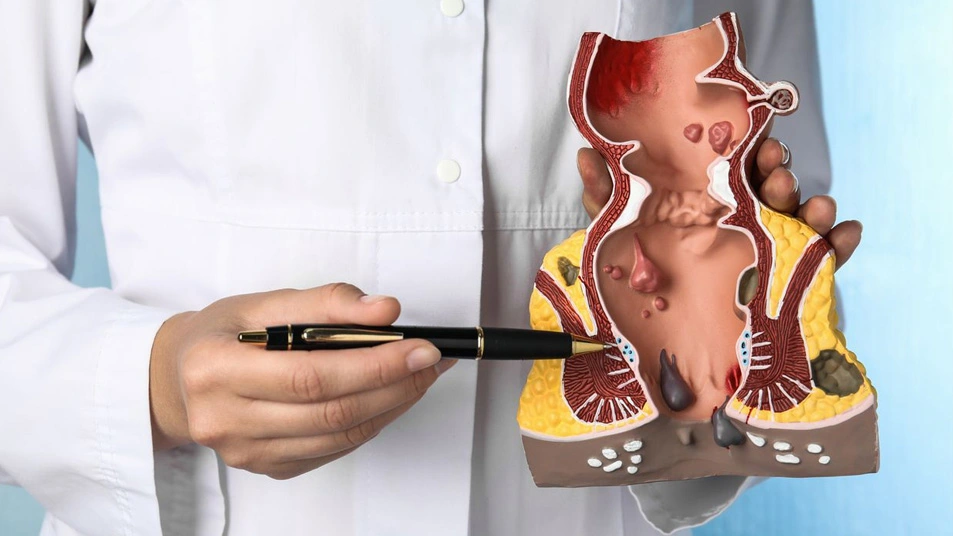
Laser Piles Surgery, Piles Clinic in Chiplun
Piles :
Haemorrhoids, or piles, are swellings that surround and contain blood vessels in the anus. They serve as cushions to enable the anus to seal completely and are a typical feature of the anus. It is typical for the piles to inflate and grow beyond what is necessary. Prolapse (anything protruding at the bottom end) and an itching bottom are common symptoms. Bleeding is often bright crimson in color. It's a benign ailment that often requires bandaging or surgery, modest therapy like ointments, or no treatment at all.
Piles have a number of causes, but often the cause is unknown. Fortunately, effective options are available to treat piles. Many people get relief with home treatments and lifestyle changes.
Causes of Piles or Haemorrhoids :
In actuality, hard stools and constipation are the root causes of piles. For some people, piles are the result of elevated pressure in the lower rectum. The patient may have piles if they have firm stools and constipation. Vein pressure is the main cause of hemorrhoids.
The other common causes of Haemorrhoids or Piles include :
Chronic Constipation or Diarrhea can cause repeated strain and irritation to the anal veins.
Straining During Bowel Movements is caused due to excessive straining. Majorly constipation, can put pressure on the veins in the rectal and anal area, leading to Haemorrhoids.
Sitting for Long Periods especially on the toilet, can increase pressure on the veins in the anus.
Low Fluid Intake can lead to dehydration and hard stools, increasing the risk of constipation and straining.
Pregnancy: The increased pressure on the pelvic blood vessels from the growing uterus, as well as hormonal changes, can cause Haemorrhoids.
Heavy or frequent lifting of heavy objects can strain the abdominal muscles and veins, leading to Haemorrhoids.
Prolonged Standing or Sitting for long periods can contribute to Haemorrhoids development by increasing pressure on the rectal veins.
Symptoms of Piles or Haemorrhoids :
Mostly, the symptoms of piles are not very complicated. Piles can be resolved on their own after some days. The symptoms can vary depending on the type and severity of the condition.
Some common symptoms of Piles...
Bleeding : Bright red blood may be seen on toilet paper, in the toilet bowl, or on the surface of the stool after a bowel movement.
Pain and Discomfort : Pain or discomfort, especially during bowel movements or when sitting, is common. Internal Haemorrhoids usually cause less pain compared to external ones unless they prolapse.
Itching or Irritation : The anal region can become itchy or irritated.
Swelling : Lumps or swelling can be felt around the anus. This is more common with external Haemorrhoids.
Mucus Discharge : There might be a mucus discharge from the anus.
Prolapse : Internal Haemorrhoids can prolapse, meaning they can push through the anal opening, causing a lump to protrude.
A feeling of incomplete evacuation : Some individuals may feel that their bowel movements are not complete even after they've gone to the toilet.
Thrombosis : If a blood clot forms within an external Haemorrhoids, it can cause severe pain, inflammation, swelling, and a hard lump near the anus. People visit a doctor for a medical opinion only when they notice heavy bleeding after passing a stool or painful piles.
Types of Piles :
External Piles : These are located beneath the skin near your anus. Symptoms and indicators might include Anal itchiness or irritation, pain, discomfort, swelling around the anus, and bleeding
Internal Piles : internal hemorrhoids are located inside the rectum and are usually invisible to the unaided eye, they rarely cause pain. However, while passing feces, straining or discomfort might result in blood without feeling pain with bowel motions. It's possible to find little drops of bright crimson blood in the toilet or on your toilet paper. A prolapsed or projecting hemorrhoid pulls through the anal orifice, causing discomfort and inflammation.
Thrombosed Piles : A thrombus, or clot, can form from blood pooling in an external hemorrhoid and cause severe discomfort, swelling, inflammation, or a hard lump around your anus.
Treatment / Surgery for Piles or Haemorrhoids :
Treatment for Piles :
Pain relievers like acetaminophen, ibuprofen, or aspirin can help alleviate pain.
Stool softeners or fiber supplements can prevent constipation.
Non-surgical Procedures :
Rubber Band Ligation : A rubber band is placed around the base of the Haemorrhoids to cut off blood flow, causing it to wither and fall off.
Sclerotherapy : A chemical solution is injected into the Haemorrhoids tissue to shrink it.
Coagulation : Laser, infrared, or bipolar coagulation techniques can be used to harden and shrink Haemorrhoids tissue.
Surgical Procedures for Piles or Haemorrhoids :
Hemorrhoidectomy : Surgical excision of Hemorrhoids that are severe or recurring. Although it takes longer to recuperate, this is frequently the most successful course of action.
Stapled Hemorrhoidopexy : Hemorrhoidal tissue that has gotten larger is removed surgically. Compared to an open hemorrhoidectomy, this treatment is less painful. In addition, individuals who had stapled Hemorrhoidopexy will heal more quickly and have less discomfort than those who had other surgical treatments. For patients with Grade III and Grade IV hemorrhoids, the stapled Hemorrhoidopexy has emerged as a superb standard in the current situation. Even prolapsed and external piles are present in patients with this grade of piles. Therefore, this surgical approach aids in the treatment and excision of various prolapsed and external hemorrhoids.
Laser Haemorrhoids Procedure : In this operation, the hemorrhoidal tissue is coagulated using laser beads rather than by insertion and cutting of the mucosa. The primary advantage of the laser technique over stapled Hemorrhoidopexy is that it causes less discomfort. If the patients get laser surgery, they will heal quickly and can resume their jobs as soon as feasible. The main issue with this operation is how hard it is to control the bleeding issue. The costlier nature of laser therapy is the second main issue.
